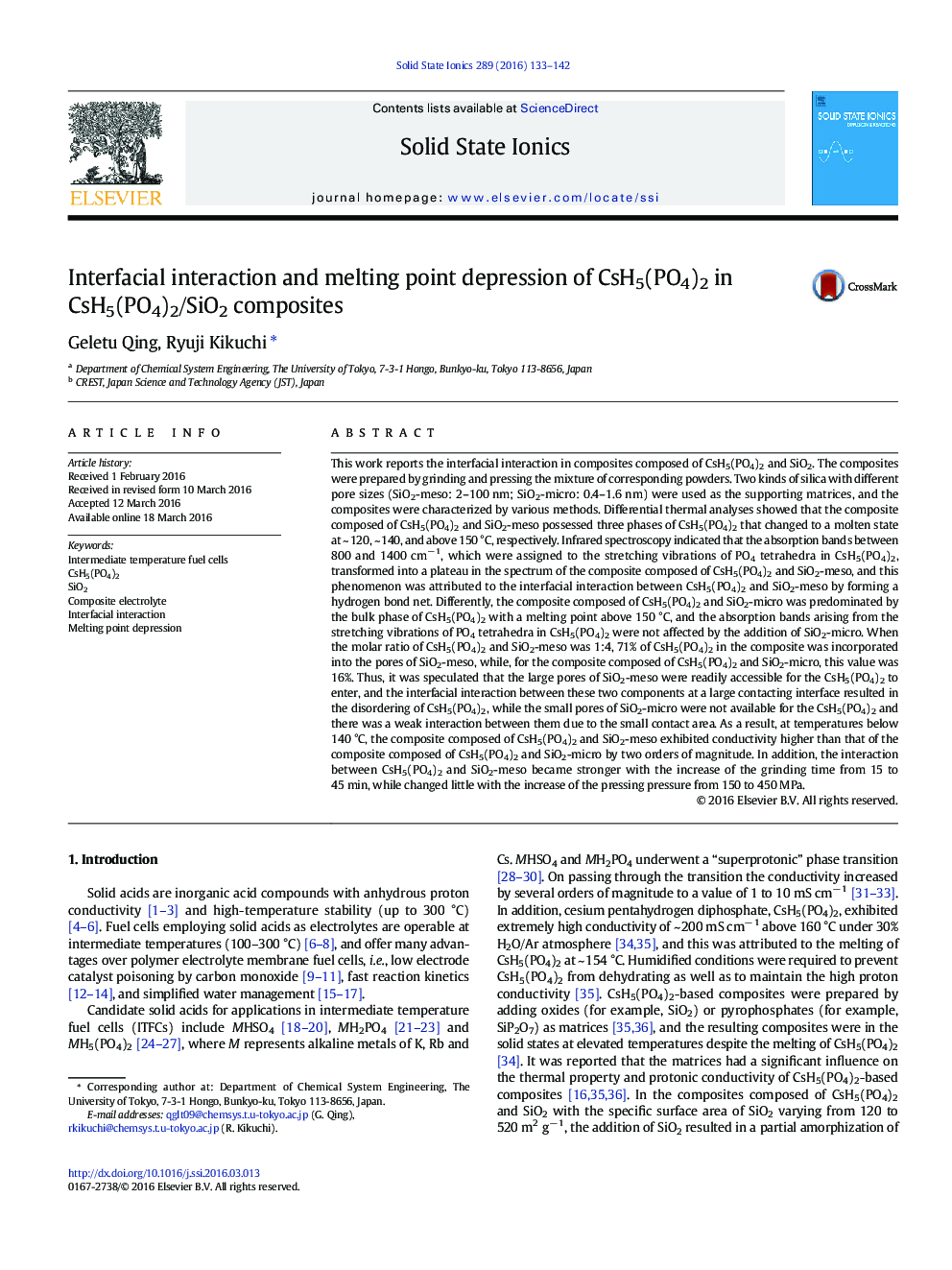| کد مقاله | کد نشریه | سال انتشار | مقاله انگلیسی | نسخه تمام متن |
|---|---|---|---|---|
| 1296161 | 1498254 | 2016 | 10 صفحه PDF | دانلود رایگان |

• Interfacial interaction in composites composed of CsH5(PO4)2 and SiO2 was reported.
• Mesoporous SiO2 showed strong interfacial interaction with CsH5(PO4)2.
• Microporous SiO2 showed weak interfacial interaction with CsH5(PO4)2.
• Mesoporous SiO2 had a larger contact area with CsH5(PO4)2 than microporous SiO2.
• Mesoporous SiO2 significantly enhanced the conductivity of CsH5(PO4)2 below 140 °C.
This work reports the interfacial interaction in composites composed of CsH5(PO4)2 and SiO2. The composites were prepared by grinding and pressing the mixture of corresponding powders. Two kinds of silica with different pore sizes (SiO2-meso: 2–100 nm; SiO2-micro: 0.4–1.6 nm) were used as the supporting matrices, and the composites were characterized by various methods. Differential thermal analyses showed that the composite composed of CsH5(PO4)2 and SiO2-meso possessed three phases of CsH5(PO4)2 that changed to a molten state at ~ 120, ~ 140, and above 150 °C, respectively. Infrared spectroscopy indicated that the absorption bands between 800 and 1400 cm− 1, which were assigned to the stretching vibrations of PO4 tetrahedra in CsH5(PO4)2, transformed into a plateau in the spectrum of the composite composed of CsH5(PO4)2 and SiO2-meso, and this phenomenon was attributed to the interfacial interaction between CsH5(PO4)2 and SiO2-meso by forming a hydrogen bond net. Differently, the composite composed of CsH5(PO4)2 and SiO2-micro was predominated by the bulk phase of CsH5(PO4)2 with a melting point above 150 °C, and the absorption bands arising from the stretching vibrations of PO4 tetrahedra in CsH5(PO4)2 were not affected by the addition of SiO2-micro. When the molar ratio of CsH5(PO4)2 and SiO2-meso was 1:4, 71% of CsH5(PO4)2 in the composite was incorporated into the pores of SiO2-meso, while, for the composite composed of CsH5(PO4)2 and SiO2-micro, this value was 16%. Thus, it was speculated that the large pores of SiO2-meso were readily accessible for the CsH5(PO4)2 to enter, and the interfacial interaction between these two components at a large contacting interface resulted in the disordering of CsH5(PO4)2, while the small pores of SiO2-micro were not available for the CsH5(PO4)2 and there was a weak interaction between them due to the small contact area. As a result, at temperatures below 140 °C, the composite composed of CsH5(PO4)2 and SiO2-meso exhibited conductivity higher than that of the composite composed of CsH5(PO4)2 and SiO2-micro by two orders of magnitude. In addition, the interaction between CsH5(PO4)2 and SiO2-meso became stronger with the increase of the grinding time from 15 to 45 min, while changed little with the increase of the pressing pressure from 150 to 450 MPa.
Journal: Solid State Ionics - Volume 289, June 2016, Pages 133–142